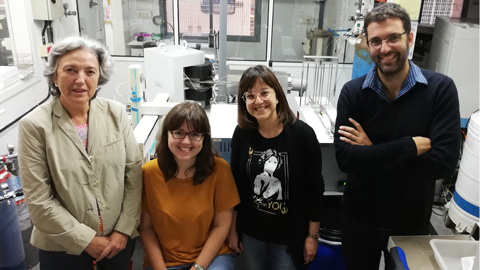Successful biological decontamination of an aquifer

23/10/2019
Researchers at the Universitat Autònoma de Barcelona (UAB), alongside LITOCLEAN and the University of Barcelona (UB), have achieved the biological decontamination of an aquifer containing a high concentration of the organochlorine compound perchloroethylene. It is one of the most pioneering experiences in bioremediation applied at large scale in Spain and represents a change in paradigm with regard to current treatments.
Organochlorine compounds, which are mainly toxic, are used as solvents and degreasers and, according to the Waste Agency of Catalonia (ARC), they represent almost 9% of the pollutants found in contaminated soils in Catalonia.
The decontamination was conducted through the biostimulation of organohalide-respiring bacteria found in the aquifer using lactate. These bacteria are capable of “breathing” the organochlorine compounds and transforming them into the non-toxic compound ethene.
The findings of this study, published in Water Research, are the result of a pioneering multidisciplinary methodology which allows specifying in each case the most adequate strategy to detoxify biologically aquifers polluted with organoclorines.
The methodology uses different techniques including the identification of the enzymes involved in the degradation of the contaminants, the degradation pathways, the changes in the isotope composition of the organochlorines, as well as the hydrogeological characteristics of the aquifer. This data as a whole provides information to decide which bioremediation strategy is more efficient: biostimulation (adding nutrients to autochthonous dechlorinating bacteria) or bioaugmentation (adding exogenous microorganisms with dechlorinating capability).
In the study published, researchers first applied this methodology in laboratory and observed that adding a nutrient such as lactate increased the “cleaning” activity of autochthonous bacteria, providing more energy and more optimal conditions for their growth. Researchers then conducted a successful pilot test in one of the aquifer's wells, in which two hundred days after the biostimulation most of the compound was transformed to non-toxic ethene. Later on, researchers proceeded to implement the treatment in all of the contaminated area. After one year, the monitoring analyses revealed the transformation of perchloroethylene into ethene in the majority of the aquifer's wells, and currently fulfil the parameters set down by the Catalan Water Agency.
Aquifer Treatments
A good chemical state of aquifers is a priority, given that they constitute the main source of drinkable water for almost 75% of Europe's inhabitants. Its importance becomes even more relevant within the current context of climate change, since the increase in frequency of extreme events such as droughts and flooding will cause surface water sources to become less reliable and the demand for underground water to rise.
“To decontaminate aquifers, the majority of Spanish companies and consultancies choose to use physico-chemical treatments, which have been demonstrated to be effective in treating the source of the contamination, but are currently considered insufficient for the concentrations set by the competent authorities”, explains Ernest Marco, researcher at the UAB Department of Chemical, Biological and Environmental Engineering and director of this line of research at the Biodegradation of Industrial Contaminants and Waste Valorization Group (BioremUAB). He adds: “it represents a change in paradigm with regard to current treatments and we hope this will serve to no longer consider it an ‘immature’ technique and work towards its use”.
“Our study gives consistency to the application of biological treatments to reach our set objectives. These are efficient and economic, and currently there are a wide array of techniques to conduct an adequate diagnosis and monitoring without noticeable additional costs”, highlights Monica Rosell, researcher at the MAiMA research group of the Faculty of Earth Sciences and at the Water Research Institute (IdRA) of the UB.
“One of the most positive parts of this project is that it has allowed us to work in real conditions and apply our laboratory conclusions to a case existing in the field”, PhD student Natàlia Blázquez Pallí points out.
The study was carried out in the Barcelona province. It was directed and coordinated by the three institutions within the framework of the Government of Catalonia's Industrial Doctorates Plan between the BioremUAB group and the environmental engineering company LITOCLEAN, S.L.
Original article: Blázquez-Pallí N, Rosell M, Varias J, Bosch M, Soler A, Vicenta T, Marco-Urrea E. Integrative isotopic and molecular approach for the diagnosis and implementation of an efficient in-situ enhanced biological reductive dechlorination of chlorinated ethenes. Water Research, Vol. 167, 15 December 2019, 115106. https://doi.org/10.1016/j.watres.2019.115106